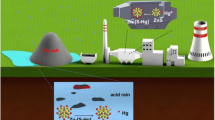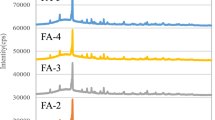Abstract
The reaction of Hg2+ with sulfite is a major identified reduction pathway in the atmosphere. UV absorption spectroscopy was used to study the kinetics of Hg2+ reduction by sulfite (Na2SO3) in the presence of fly ash. Upon the addition of Cumberland and Shawnee fly ash samples, the reduction rates were 0.0071 ± 0.0008 and 0.0009 ± 0.0006 s−1, respectively. This represents c.a. 40 and 90 % decreases in the homogeneous rate, 0.013 ± 0.007 s−1. The reduction reaction was also observed when Cumberland was added without Na2SO3. Sulfur elemental analyzer and high-resolution field emission scanning microscopy with energy dispersive X-ray spectroscopy (HR-FE-SEM-EDS) characterization confirmed that Cumberland fly ash particles were rich in sulfur. Nanoparticle Tracking Analysis (NTA) determined the mean particle size in solution to be 246 ± 25 nm for Cumberland fly ash and 198 ± 14 nm for Shawnee. To obtain further insight on observed Hg2+ homogeneous reduction rates by sulfite, the effects of several environmental variables were investigated. Hg(NO3)2 and HgO were used as the sources of Hg2+. Extended pH (1–7) and temperature (1.0–45.0 °C) ranges were studied for the first time. The enthalpies of activation for the HgO reduction were 94 ± 3 kJ mol−1 at pH 1 and 92 ± 4 kJ mol−1 at pH 3, while the entropies were 33 ± 9 J mol−1 K−1 at pH 1 and 30 ± 10 J mol−1 K−1 at pH 3. It was determined that increasing ionic strength, especially with nitrate species, slows down the reaction at pH = 7. Significance of the results on the variability of mercury reduction by sulfite at various environmental conditions, and its implication in modelling are discussed.






Similar content being viewed by others
References
Amirbahman, A., Kent, D. B., Curtis, G. P., & Marvin-DiPasquale, M. C. (2013). Kinetics of homogeneous and surface-catalyzed mercury (II) reduction by iron (II). Environmental Science and Technology, 47, 7204–7213.
Ariya, P. A., Dastoor, A. P., Amyot, M., Schroeder, W. H., Barrie, L., Anlauf, K., Raofie, F., Ryzhkov, A., Davignon, D., & Lalonde, J. (2004). The Arctic: a sink for mercury. Tellus Series B, 56, 397–403.
Ariya, P. A., Peterson, K., Snider, G., & Amyot, M. (2009). Mercury chemical transformations in the gas, aqueous and heterogeneous phases: state-of-the-art science and uncertainties (pp. 459–501). Mercury Fate and Transport in the Global Atmosphere: Springer.
Burda, C., Chen, X., Narayanan, R., & El-Sayed, M. A. (2005). Chemistry and properties of nanocrystals of different shapes. Chemical Reviews, 105, 1025–1102.
Clever, H. L., Johnson, S. A., & Derrick, M. E. (1985). The solubility of mercury and some sparingly soluble mercury salts in water and aqueous electrolyte solutions. Journal of Physical and Chemical Reference Data, 14, 631–680.
Davidson, P. W., Myers, G. J., & Weiss, B. (2004). Mercury exposure and child development outcomes. Pediatrics, 113, 1023–1029.
Deeds, D. A., Banic, C. M., Lu, J., & Daggupaty, S. (2013). Mercury speciation in a coal-fired power plant plume: an aircraft-based study of emissions from the 3640 MW Nanticoke Generating Station, Ontario, Canada. Journal of Geophysical Research – Atmospheres, 118, 4919–4935.
Ebinghaus, R., Kock, H. H., Temme, C., Einax, J. W., Löwe, A. G., Richter, A., Burrows, J. P., & Schroeder, W. H. (2002). Antarctic springtime depletion of atmospheric mercury. Environmental Science and Technology, 36, 1238–1244.
Engler, R. (1985). Many Bhopal’s—technology out of control. Nation, 240, 488–500.
Eriksen, M., Mason, S., Wilson, S., Box, C., Zellers, A., Edwards, W., Farley, H., & Amato, S. (2013). Microplastic pollution in the surface waters of the Laurentian Great Lakes. Marine Pollution Bulletin, 77, 177–182.
Evans, M. G., & Polanyi, M. (1935). Some applications of the transition state method to the calculation of reaction velocities, especially in solution. Transactions of the Faraday Society, 31, 875–894.
Fitzgerald, W. F., Lamborg, C. H., & Hammerschmidt, C. R. (2007). Marine biogeochemical cycling of mercury. Chemical Reviews, 107, 641–662.
Fujita, S., Horii, H., & Taniguchi, S. (1973). Pulse radiolysis of mercuric ion in aqueous solutions. Journal of Physical Chemistry, 77, 2868–2871.
Gallego-Urrea, J. A., Tuoriniemi, J., Pallander, T., & Hassellöv, M. (2010). Measurements of nanoparticle number concentrations and size distributions in contrasting aquatic environments using nanoparticle tracking analysis. Environmental Chemistry, 7, 67–81.
Gårdfeldt, K., & Jonsson, M. (2003). Is bimolecular reduction of Hg (II) complexes possible in aqueous systems of environmental importance. Journal of Physical Chemistry A, 107, 4478–4482.
Haynes, W. M. (2012). CRC handbook of chemistry and physics. Boca Raton: CRC Press.
Hayon, E., Treinin, A., & Wilf, J. (1972). Electronic spectra, photochemistry, and autoxidation mechanism of the sulfite-bisulfite-pyrosulfite systems. SO2-, SO3-, SO4-, and SO5-radicals. Journal of the American Chemical Society, 94, 47–57.
Higginson, W. C. E. (1951). The ultra-violet absorption spectra of mercurous perchlorate solutions. Journal of the Chemical Society, 331, 1438–1443.
Hines, N. A., & Brezonik, P. L. (2004). Mercury dynamics in a small Northern Minnesota lake: water to air exchange and photoreactions of mercury. Marine Chemistry, 90, 137–149.
Houston, P. (2001). Chemical kinetics and reaction dynamics. New York, NY: McGraw-Hill Higher Education.
Huang, C., & Blankenship, D. (1984). The removal of mercury (II) from dilute aqueous solution by activated carbon. Water Research, 18, 37–46.
Kutchko, B. G., & Kim, A. G. (2006). Fly ash characterization by SEM–EDS. Fuel, 85, 2537–2544.
Lamborg, C. H., Fitzgerald, W. F., O’Donnell, J., & Torgersen, T. (2002). A non-steady-state compartmental model of global-scale mercury biogeochemistry with interhemispheric atmospheric gradients. Geochimica et Cosmochimica Acta, 66, 1105–1118.
Malisoff, W. M., & Anding, C. E., Jr. (1935). Determination of mercaptans in hydrocarbon solvents: an improvement of the silver nitrate method. Industrial and Engineering Chemistry, Analytical Edition, 7, 86–88.
Morel, F. M., Kraepiel, A. M., & Amyot, M. (1998). The chemical cycle and bioaccumulation of mercury. Annual Review of Ecological Systems, 543–566.
Munthe, J., Xiao, Z., & Lindqvist, O. (1991). The aqueous reduction of divalent mercury by sulfite. Water, Air, and Soil Pollution, 56, 621–630.
Namasivayam, C., & Kadirvelu, K. (1999). Uptake of mercury (II) from wastewater by activated carbon from an unwanted agricultural solid by-product: coirpith. Carbon, 37, 79–84.
Pehkonen, S. O., & Lin, C.-J. (1998). Aqueous photochemistry of mercury with organic acids. Journal of the Air and Waste Management Association, 48, 144–150.
Pósfai, M., Anderson, J. R., Buseck, P. R., & Sievering, H. (1999). Soot and sulfate aerosol particles in the remote marine troposphere. Journal of Geophysical Research – Atmospheres, 104, 21685–21693.
Poulain, A. J., Garcia, E., Amyot, M., Campbell, P. G., Raofie, F., & Ariya, P. A. (2007). Biological and chemical redox transformations of mercury in fresh and salt waters of the high arctic during spring and summer. Environmental Science and Technology, 41, 1883–1888.
Selin, N. E. (2014). Global change and mercury cycling: challenges for implementing a global mercury treaty. Environmental Toxicology and Chemistry, 33, 1202–1210.
Sen, A. K., & De, A. K. (1987). Adsorption of mercury (II) by coal fly ash. Water Research, 21, 885–888.
Senior, C. L., Sarofim, A. F., Zeng, T., Helble, J. J., & Mamani-Paco, R. (2000). Gas-phase transformations of mercury in coal-fired power plants. Fuel Processing Technology, 63, 197–213.
Tong, Y., Eichhorst, T., Olson, M. R., Rutter, A. P., Shafer, M. M., Wang, X., & Schauer, J. J. (2014). Comparison of heterogeneous photolytic reduction of Hg (II) in the coal fly ashes and synthetic aerosols. Atmospheric Research, 138, 324–329.
Van Loon, L., Mader, E., & Scott, S. L. (2000). Reduction of the aqueous mercuric ion by sulfite: UV spectrum of HgSO3 and its intramolecular redox reaction. Journal of Physical Chemistry A, 104, 1621–1626.
Vassilev, S. V., & Vassileva, C. G. (2007). A new approach for the classification of coal fly ashes based on their origin, composition, properties, and behaviour. Fuel, 86, 1490–1512.
Wiatrowski, H. A., Das, S., Kukkadapu, R., Ilton, E. S., Barkay, T., & Yee, N. (2009). Reduction of Hg (II) to Hg (0) by magnetite. Environmental Science and Technology, 43, 5307–5313.
Wilcox, J., Rupp, E., Ying, S. C., Lim, D.-H., Negreira, A. S., Kirchofer, A., Feng, F., & Lee, K. (2012). Mercury adsorption and oxidation in coal combustion and gasification processes. International Journal of Coal Geology, 90, 4–20.
Yardim, M., Budinova, T., Ekinci, E., Petrov, N., Razvigorova, M., & Minkova, V. (2003). Removal of mercury (II) from aqueous solution by activated carbon obtained from furfural. Chemosphere, 52, 835–841.
Acknowledgements
We thank M. Sutton of Tennessee Valley Authority for providing the Cumberland and Shawnee fly ash samples and to Dr. Sewall of McGill University for his help with the Cary 100 spectrophotometer. We are grateful to Natural Science and Engineering Research Council of Canada, Canadian Foundation for Innovation and Environment Canada and CARA program for financial support.
Author information
Authors and Affiliations
Corresponding author
Electronic Supplementary Material
Below is the link to the electronic supplementary material.
ESM 1
(DOCX 2581 kb)
Rights and permissions
About this article
Cite this article
Feinberg, A.I., Kurien, U. & Ariya, P.A. The Kinetics of Aqueous Mercury(II) Reduction by Sulfite Over an Array of Environmental Conditions. Water Air Soil Pollut 226, 119 (2015). https://doi.org/10.1007/s11270-015-2371-0
Received:
Accepted:
Published:
DOI: https://doi.org/10.1007/s11270-015-2371-0




